Construct a Table of Total Percentages. Upload
Whatsoever assay in Tableau tin be expressed in terms of percentages. For case, rather than viewing sales for every product, yous might want to view each production's sales as a pct of the full sales for all products.
Near percentages
There are 2 factors that contribute to the pct calculation:
1. The information to which you compare all percent calculations
Percentages are a ratio of numbers. The numerator is the value of a given mark. The denominator depends on the blazon of percentage y'all want, and is the number to which you compare all your calculations. The comparing can be based on the entire table, a row, a pane, and and then on. Past default, Tableau uses the entire table. Other percentage calculations are available via the Pct of menu detail. Meet Percentage options.
The figure below is an example of a text table with percentages. The percentages are calculated with the Sales measure aggregated every bit a summation, and are based on the entire tabular array.
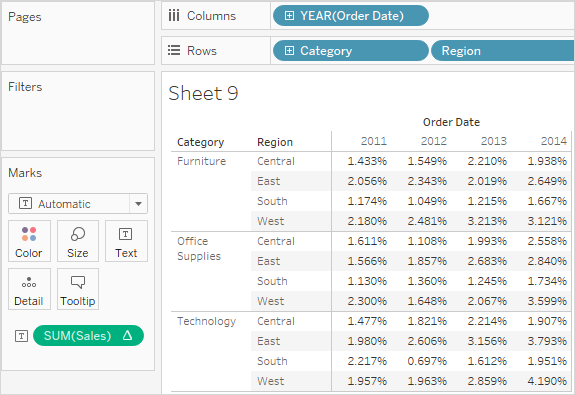
2. The assemblage
Percentages are computed on the footing of the assemblage for each measure. Standard aggregations include summation, average, and several others. See Data Aggregation in Tableau for more information.
For instance, if the aggregation applied to the Sales measure out is a summation, then the default pct calculation (percent of table) means that each number displayed is the SUM(Sales) for that mark divided past the SUM(Sales) for the entire table.
In addition to using predefined aggregations, you can apply custom aggregations when calculating percentages. You define your own aggregations by creating a calculated field. One time the new field is created, yous can use percentages on the field as you would whatever other field. See Aggregate Functions in Tableau(Link opens in a new window) for more than data.
Percent calculations can also be practical to disaggregated data. In this case, all values are expressed as the percentage of a summation. You cannot cull any other assemblage.
Example
The view below shows a nested bar chart created using two dimensions and a measure that is aggregated as a maximum. Additionally, the information are colour-encoded by a dimension and the default percentage calculation has been applied. Notice that the axis labels are modified to reflect the percent adding.
The tooltip reveals that the maximum sales for furniture in the east in 2011 is 17.70% of the maximum for the unabridged table. What is the maximum for the table? If you recreate the view you'll see that the maximum occurs in the South, in the Applied science category, in the year 2011. The tooltip for this bar segment would reveal a maximum sales of 100%.
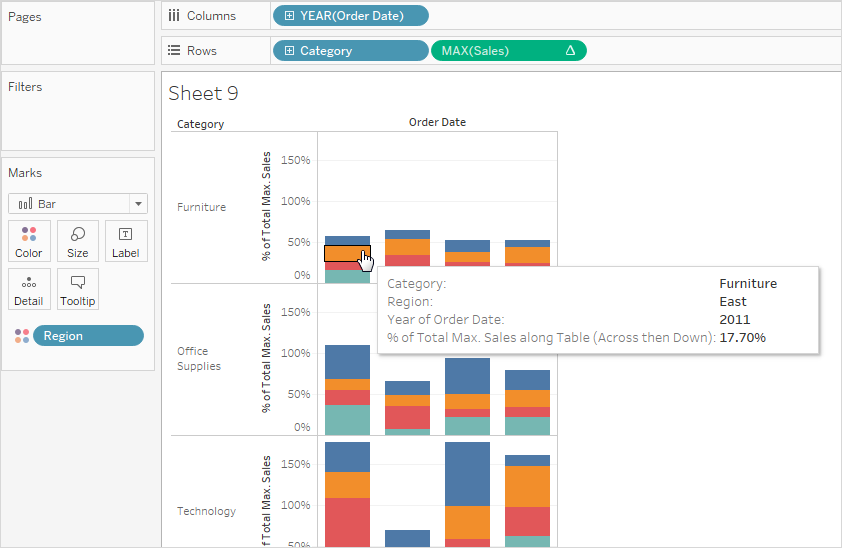
The adjacent view displays ii disaggregated measures as a scatter plot. Again, the default percent calculation has been applied as reflected by the modified axis labels.
The tooltip shows that the selected data betoken constitutes -0.475 pct of total profit and a 0.3552 pct of full sales. Percentage calculations are based on the entire data source.

How to calculate percentages
To calculate percentages in your visualization:
- Select Assay > Percentages Of, and then select a percentage pick.
Percentage options
Computing a pct involves specifying a total on which the percentage is based. The default percentage calculation is based on the entire table. Yous can also cull a unlike option.
The option you choose is applied uniformly to all measures that appear on a worksheet. You cannot choose Percent of Column for one measure and Pct of Row for another.
The percent options on the Analysis menu correspond to the percent table calculations. When yous select a per centum option, you are actually calculation a Percent of Total tabular array calculation. See Transform Values with Table Calculations for more information.
If you are unsure what the electric current percent calculation means, brandish the yard totals. This provides more than data most each row and column. For case, if you select Percent of Row while displaying yard totals, you volition meet that the total for each row is exactly 100%. Run across Show Totals in a Visualization for more data on thou totals.
The percent calculation options are described in the following sections. In each case, the grand totals are displayed every bit well.
Per centum of Table
When you select Percentage Of > Table from the Analysis menu, each measure on the worksheet is expressed as a pct of the total for the unabridged worksheet (table). For example, Applied science in the Due east region accounts for 3.79% of total sales in 2014. The yard totals for rows show that 2014 accounts for 31.95% of the total sales. Summing the grand totals for rows or for columns yields 100% of the total.
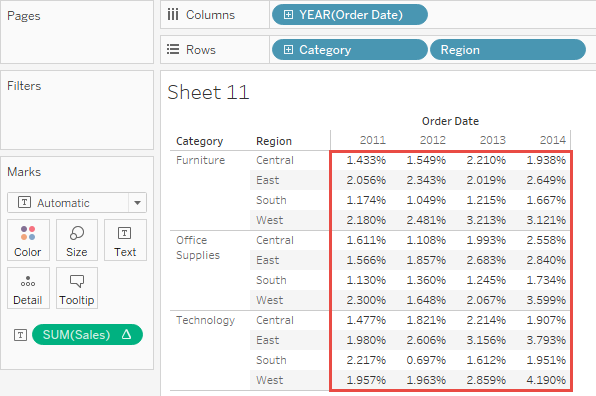
Per centum of Column
When you lot select Per centum of > Cavalcade from the Analysis menu, each measure on the worksheet is expressed as a percentage of the total for the cavalcade. The values within the red box add upwards to 100%.

Percent of Row
When y'all select Percentage of Row, each measure on the worksheet is expressed as a percentage of the total for the row. The values within the red box add together upward to 100%.
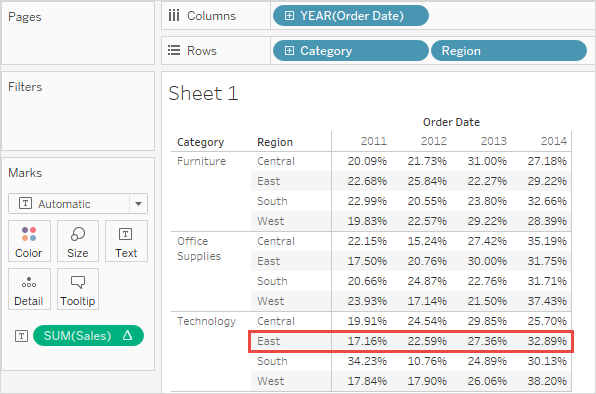
Percent of Pane
When you select Percentage of > Pane from the Analysis menu, each measure out on the worksheet is expressed as a pct of the total for the panes in the view. This choice is equivalent to Per centum of Tabular array when the table consists of just a single pane.
In the following view, the red box constitutes a unmarried pane; the values within the red box add up to 100%.
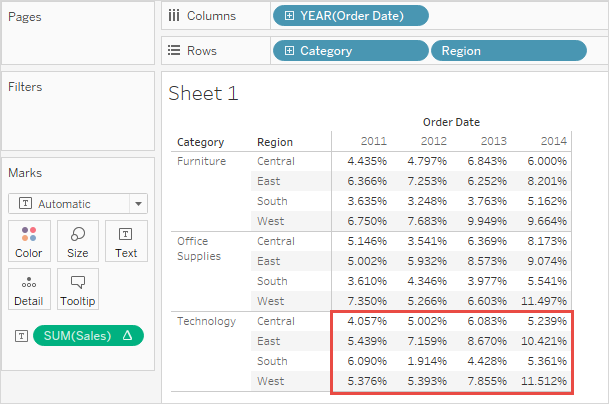
Percent of Row in Pane
When y'all select Percentage of > Row in Pane from the Analysis menu, each mensurate on the worksheet is expressed as a percentage of the total for a row within a pane. This option is equivalent to as Pct of Row when the table is only a single pane wide.
In the following view, the cerise box constitutes a row within a pane; the values within the ruby box add up to 100%.
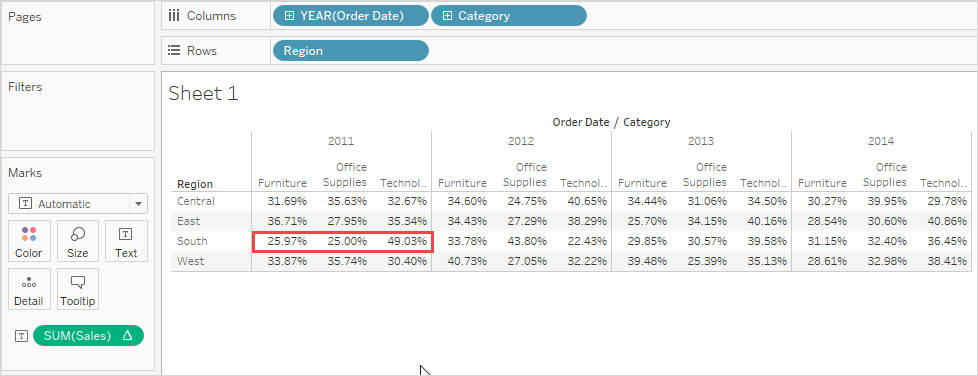
Note: If you place Measure out Names every bit the inner dimension on the Columns shelf (that is, the dimension farthest to the right), Tableau volition return 100% for each mark because y'all cannot total up the values for multiple measure names. For case, you can't total upwardly the values for SUM(Sales) and SUM(Turn a profit).
Percent of Column in Pane
When you select Percentage of > Cavalcade in Pane from the Analysis bill of fare, each measure in the worksheet is expressed equally a pct of the total for a column within a pane. This pick is equivalent to as Pct of Cavalcade when the tabular array is only a unmarried pane high.
In the following view, the ruby box constitutes a cavalcade inside a pane; the values within the ruby box add upward to 100%.
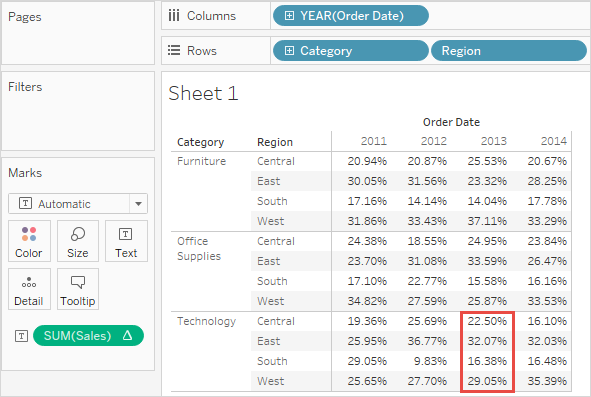
If y'all identify Measure Names as the inner dimension on the Rows shelf (that is, the dimension uttermost to the right on the shelf), Tableau will render 100% for each mark considering you lot cannot full up the values for multiple measure out names. For example, you can't full upward the values for SUM(Sales) and SUM(Profit).
Percent of Jail cell
When you lot select Percentage Of > Cell from the Analysis menu, each mensurate on the worksheet is expressed equally a percentage of the total for each private cell in the view. Almost views prove simply one value per cell, in which case all cells show a per centum of 100%. But in some cases, as, for example, when you disaggregate data, a unmarried cell tin can contain multiple values:
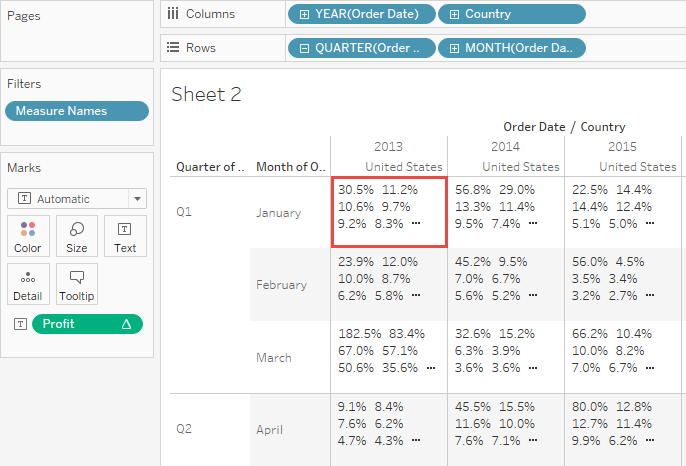
Source: https://help.tableau.com/current/pro/desktop/en-us/calculations_percentages_options.htm
0 Response to "Construct a Table of Total Percentages. Upload"
Post a Comment